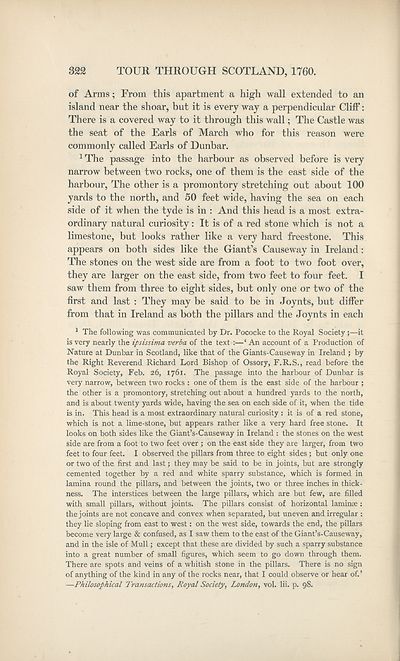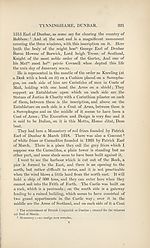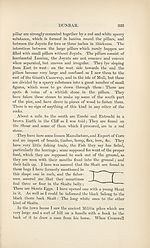Series 1 > Tours in Scotland 1747, 1750, 1760
(409) Page 322
Download files
Complete book:
Individual page:
Thumbnail gallery: Grid view | List view

TOUR THROUGH SCOTLAND, 1760.
of Arms; From this apartment a high wall extended to an
island near the shoar, but it is every way a perpendicular Clift*:
There is a covered way to it through this wall; The Castle was
the seat of the Earls of March who for this reason were
commonly called Earls of Dunbar.
1 The passage into the harbour as observed before is very
narrow between two rocks, one of them is the east side of the
harbour, The other is a promontory stretching out about 100
yards to the north, and 50 feet wide, having the sea on each
side of it when the tyde is in : And this head is a most extra¬
ordinary natural curiosity: It is of a red stone which is not a
limestone, but looks rather like a very hard freestone. This
appears on both sides like the Giant’s Causeway in Ireland:
The stones on the west side are from a foot to two foot over,
they are larger on the east side, from two feet to four feet. I
saw them from three to eight sides, but only one or two of the
first and last : They may be said to be in Joynts, but differ
from that in Ireland as both the pillars and the Joynts in each
1 The following was communicated by Dr. Pococke to the Royal Society ;—it
is very nearly the ipsissima verba of the text :—‘ An account of a Production of
Nature at Dunbar in Scotland, like that of the Giants-Causeway in Ireland ; by
the Right Reverend Richard Lord Bishop of Ossory, F.R.S., read before the
Royal Society, Feb. 26, 1761. The passage into the harbour of Dunbar is
very narrow, between two rocks : one of them is the east side of the harbour ;
the other is a promontory, stretching out about a hundred yards to the north,
and is about twenty yards wide, having the sea on each side of it, when the tide
is in. This head is a most extraordinary natural curiosity : it is of a red stone,
which is not a lime-stone, but appears rather like a very hard free stone. It
looks on both sides like the Giant’s-Causeway in Ireland : the stones on the west
side are from a foot to two feet over ; on the east side they are larger, from two
feet to four feet. I observed the pillars from three to eight sides ; but only one
or two of the first and last; they may be said to be in joints, but are strongly
cemented together by a red and white sparry substance, which is formed in
lamina round the pillars, and between the joints, two or three inches in thick¬
ness. The interstices between the large pillars, which are but few, are filled
with small pillars, without joints. The pillars consist of horizontal laminae :
the joints are not concave and convex when separated, but uneven and irregular :
they lie sloping from east to west: on the west side, towards the end, the pillars
become very large & confused, as I saw them to the east of the Giant’s-Causeway,
and in the isle of Mull; except that these are divided by such a sparry substance
into a great number of small figures, which seem to go down through them.
There are spots and veins of a whitish stone in the pillars. There is no sign
of anything of the kind in any of the rocks near, that I could observe or hear of.’
—Philosophical Transactions, Royal Society, London, vol. Hi. p. 98.
of Arms; From this apartment a high wall extended to an
island near the shoar, but it is every way a perpendicular Clift*:
There is a covered way to it through this wall; The Castle was
the seat of the Earls of March who for this reason were
commonly called Earls of Dunbar.
1 The passage into the harbour as observed before is very
narrow between two rocks, one of them is the east side of the
harbour, The other is a promontory stretching out about 100
yards to the north, and 50 feet wide, having the sea on each
side of it when the tyde is in : And this head is a most extra¬
ordinary natural curiosity: It is of a red stone which is not a
limestone, but looks rather like a very hard freestone. This
appears on both sides like the Giant’s Causeway in Ireland:
The stones on the west side are from a foot to two foot over,
they are larger on the east side, from two feet to four feet. I
saw them from three to eight sides, but only one or two of the
first and last : They may be said to be in Joynts, but differ
from that in Ireland as both the pillars and the Joynts in each
1 The following was communicated by Dr. Pococke to the Royal Society ;—it
is very nearly the ipsissima verba of the text :—‘ An account of a Production of
Nature at Dunbar in Scotland, like that of the Giants-Causeway in Ireland ; by
the Right Reverend Richard Lord Bishop of Ossory, F.R.S., read before the
Royal Society, Feb. 26, 1761. The passage into the harbour of Dunbar is
very narrow, between two rocks : one of them is the east side of the harbour ;
the other is a promontory, stretching out about a hundred yards to the north,
and is about twenty yards wide, having the sea on each side of it, when the tide
is in. This head is a most extraordinary natural curiosity : it is of a red stone,
which is not a lime-stone, but appears rather like a very hard free stone. It
looks on both sides like the Giant’s-Causeway in Ireland : the stones on the west
side are from a foot to two feet over ; on the east side they are larger, from two
feet to four feet. I observed the pillars from three to eight sides ; but only one
or two of the first and last; they may be said to be in joints, but are strongly
cemented together by a red and white sparry substance, which is formed in
lamina round the pillars, and between the joints, two or three inches in thick¬
ness. The interstices between the large pillars, which are but few, are filled
with small pillars, without joints. The pillars consist of horizontal laminae :
the joints are not concave and convex when separated, but uneven and irregular :
they lie sloping from east to west: on the west side, towards the end, the pillars
become very large & confused, as I saw them to the east of the Giant’s-Causeway,
and in the isle of Mull; except that these are divided by such a sparry substance
into a great number of small figures, which seem to go down through them.
There are spots and veins of a whitish stone in the pillars. There is no sign
of anything of the kind in any of the rocks near, that I could observe or hear of.’
—Philosophical Transactions, Royal Society, London, vol. Hi. p. 98.
Set display mode to:
![]() Universal Viewer |
Universal Viewer | ![]() Mirador |
Large image | Transcription
Mirador |
Large image | Transcription
Images and transcriptions on this page, including medium image downloads, may be used under the Creative Commons Attribution 4.0 International Licence unless otherwise stated. ![]()
| Scottish History Society volumes > Series 1 > Tours in Scotland 1747, 1750, 1760 > (409) Page 322 |
|---|
| Permanent URL | https://digital.nls.uk/126607665 |
|---|
| Attribution and copyright: |
|
|---|
| Description | Over 180 volumes, published by the Scottish History Society, containing original sources on Scotland's history and people. With a wide range of subjects, the books collectively cover all periods from the 12th to 20th centuries, and reflect changing trends in Scottish history. Sources are accompanied by scholarly interpretation, references and bibliographies. Volumes are usually published annually, and more digitised volumes will be added as they become available. |
|---|


